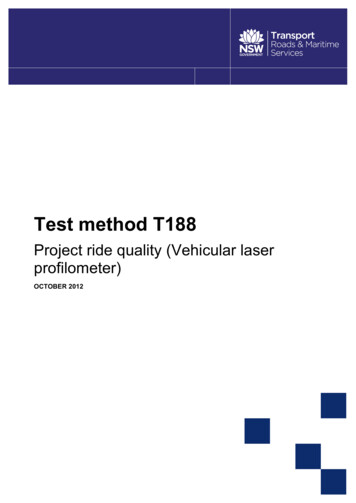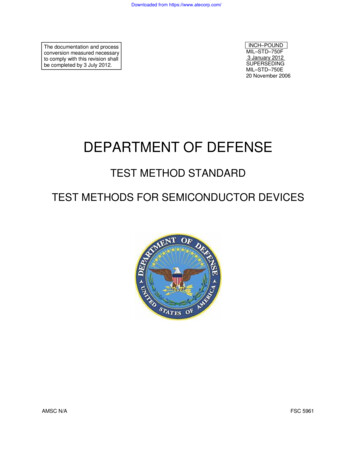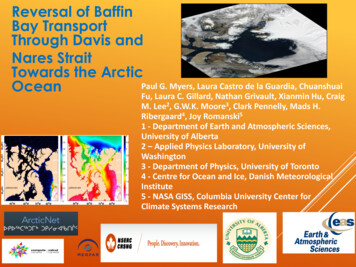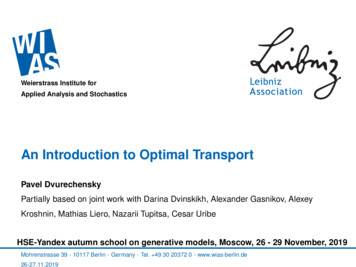
Transcription
Test method T188Project ride quality (Vehicular laserprofilometer)OCTOBER 2012
Revision SummaryEd/RevNumberEd 1/Rev 0ClauseNumberAllDescription of RevisionNew Issue.Ed 2/ Rev 0AllDateG HallApr 2009D. HazellSept 2010Headers CorrectedD. HazellJune 2010Reformatted RMS templateJ FriedrichOctober 2012Ed 1/ Rev 1Ed 1/ Rev 2AuthorisationNote that Roads and Maritime Services is hereafter referred to as ‘RMS’.The most recent revision to Test method T188 (other than minor editorial changes) are indicatedby a vertical line in the margin as shown here.Test method T188 - Project ride quality (Vehicular laser profilometer)(i)
October 2012Test method T188Project ride quality (Vehicular laser profilometer)1.ScopeThis Test Method sets out the procedure for measuring the roughness of a surface using a laserprofilometer mounted on a vehicle. This Test Method determines the ride quality for quality assurancetesting of a construction or maintenance project.NOTE: The Test Method is based on Austroads Test Method AG:AM/T001 and T187.The clause numbering in this Test Method generally parallels the numbering in the Austroads Test Method andnot the usual numbering system.2.General(a)This Test Method uses the Single Track IRI track averaging (quarter-car) method.NOTE: The profile averaging method (also know as the half-car method) is not used.(b)Operate the equipment in accordance with this Test Method in conjunction with themanufacturer’s User Manual. Where there is a conflict this Test Method prevails.(c)The roughness is tested as Test Lanes and Sections that may encompass more than one Lot asdefined in Q.(d)A Section must be 100 1 m in length. The ride quality for Sections that are outside the tolerancedo not comply with the Test Method.(e)Ride quality is based on 3 runs in each Test Lane.(c)Path L and Path R are to be parallel within each Test Lane and have a transverse spacing of 1.5 mapart.(f)Roughness results from different types of equipment must not be combined (e.g. an IRI from theWalking Profiler must not be combined with an IRI from laser profilometer or vice versa).(g)NAASRA Roughness is not required to be calculated.(h)For network surveys of ride quality use T187.(i)Referenced documents include:(i)NOTE:(ii)NOTE(iii)3.Austroads Test Method AG:AM/T001 - Pavement Roughness Measurement with an InertialLaser Profilometer Amendment No. 1 dated 26 March 2007 (abbreviated as thod1/AGAMT001 Roughness survey.pdfAustroads Test Method AG:AM/T003 - Validation of an Inertial Laser Profilometer forMeasuring Pavement Roughness (Loop Method) Amendment No. 1 dated 26 March 2007(abbreviated as thod1/AGAMT003 Roughness validation 2.pdfManufacturer’s User Manual for the inertial laser profilometer.Definitions(a)Longitudinal profileLongitudinal profile is the shape of a pavement surface measured as vertical distances from a datumhorizontal plane in the direction of traffic flow testing.(b)Laser profilometerA laser profilometer (or laser profiler) is a vehicle fitted with a laser-based measurement system thatrecords the measured longitudinal road profile (VLP).Test method T188 - Project ride quality (Vehicular laser profilometer)1 of 8
October 2012(c)International Roughness Index (IRI)The IRI is a mathematical model of the dynamic response of a real vehicle travelling along a singlewheelpath (or wheel track) of longitudinal road profile, referred to as the quarter-car (or WorldBank) model. The IRI is expressed in terms of accumulated displacement of the simulatedsuspension in metres per measured kilometre (m/km). IRI can be reported in different ways. ThisTest Method uses the Single Track IRI based on a quarter-car model run at 80 km/h over a singlewheelpath of longitudinal profile (ASTM E 1926-98 2003).(d)[Not used](e)CalibrationISO (1993) defines ‘calibration’ as: [a] set of operations that establish, under specified conditions,the relationship between values of quantities indicated by a measuring instrument or measuringsystem, of values represented by a material measure or a reference material, and the correspondingvalues realised by [measurement] standards.(f)ValidationISO (1994) defines ‘validation’ as: confirmation, through the provision of objective evidence thatrequirements for a specific intended use or application have been fulfilled.(g)Validated Speed Range (VSR)The range of test speeds where the system validation has been successfully carried out. Profile datacollected outside the VSR is non-complying.NOTE: This is not necessarily the speed range claimed by the manufacturer.(h)Test LaneThe lane to be surveyed that is at least 2.0 m wide and consists of two parallel paths.(i)SectionA Test Lane is divided into Sections that are 100 m in length.(j)Section IRI (IRIS)This represents the ride quality of a Section and is determined by averaging the individual SingleTrack IRI values obtained in each parallel path 1.5 m apart.(k)End SectionThe last part of a Test Lane that is shorter than 100 m and is less than the minimum. The resultsfor End Sections are not combined with an adjoining Section.NOTE: While the End Section is not reported in this test method, an alternative form of testing may be required.4.Apparatus(a)An inertial laser profilometer consisting of the following:(i)A vehicular platform capable of transporting testing equipment, mounting the profilemeasuring equipment and travelling at a range of speeds up to the limit of the operatingrange of the profile measuring equipment.(ii)Accelerometer(s) to establish the inertial reference which enables reference to be maintainedat the level of resolution and accuracy required for the displacement measurementtransducer(s).(iii)A displacement transducer (laser device), which measures the distance between theaccelerometer and the travelled surface. The displacement transducer(s) shall be set to ensuremid-range operation during normal operation. When measuring the profile of twowheelpaths simultaneously, a laser transducer/accelerometer combination shall be used foreach wheelpath. The lateral distance between the displacement transducers to measure in thewheelpaths shall be 1.5 0.1 m (i.e. positioned 0.75 m from each side the centreline of a lanethe vehicle).(iv)A distance measuring transducer capable of measuring the distance travelled to an accuracyof 0.1%. The transducer shall provide input to the data logger to record the distancetravelled from the start of the collection survey.Test method T188 - Project ride quality (Vehicular laser profilometer)2 of 8
October 2012(b)(v)A data logger capable of capturing the output data from the transducers at known equalintervals that are not greater than 50 mm and within the range of wave lengths of 0.5 m and50 m.(vi)A processing computer to analyse the profile data, and by applying the ‘quarter car’ modelobtain IRI for a single wheelpath and Lane Section IRIFlat base plates, gauge blocks and any other equipment required by the manufacturer’s User Manualfor the calibration of the laser displacement transducers. The tolerances on all dimensions of thegauge block is 0.01 mm unless otherwise specified by the manufacturer.5.Calibration and Validation5.1Equipment calibration5.1.1 Distance transducer(a)The distance transducer must be calibrated by driving the host vehicle over a known distance (1 kmto an accuracy of 1 m) and recording the number of pulses or ticks produced by the transducer.(b)The calibration factor and associated information, such as the date and time of calibration, is thenstored and used for all subsequent testing until such time as a new distance calibration isperformed.(c)The distance calibration must be performed checked at least once every 4 weeks whenever adistance transducer is fitted on the vehicle and or immediately following any change to the distancetransducer or change to any part of the host vehicle that may interfere with the existing calibrationconstant (e.g. change of wheels or tyres). Carry out distance calibration whenever the distance checkdoes not meet the required accuracy.5.1.2 Accelerometers(a)Calibration and checking of the accelerometers must be undertaken in accordance with themanufacturer’s requirements and procedures (refer manufacturer’s User Manual).5.1.3 Laser displacement transducers(a)The laser displacement transducers must be calibrated using the gauge blocks and flat plates inaccordance with the manufacturer’s requirements (refer manufacturer’s User Manual).(b)5.2The transducers must be calibrated immediately following any change to the laser transducers or achange to any part of the host vehicle that may interfere with the existing calibration.System Validation(a)A system validation must have been carried out in accordance with Austroads Test MethodAG:AM/T003 except that the location and length of the “Roughness Calibration Loop” may beredefined by the RMS.(b)The accreditation of the system validation must be in the previous 12 months of the date of testing.The most recent accreditation is also deemed to have expired when the process of system validationis attempted but fails to meet the system validation requirements.6.Procedure6.1Pre-test set-up(a)Tyres shall be maintained at the manufacturer’s recommended tyre pressure.(b)All testing equipment and cables must be correctly mounted, connected and secure, as per themanufacturer’s User Manual.(c)If the laser equipment is of a demountable design, calibrate the vertical distance transducers usingthe step gauge block and flat plates at least every 4 weeks or each time the lasers mounting bar isadjusted or refitted to the vehicle.(d)Ensure that the serial numbers (or other information that allows traceability to calibrationdocumentation) are recorded for all sensors.Test method T188 - Project ride quality (Vehicular laser profilometer)3 of 8
October 20126.26.3(e)Perform manufacturer’s operational validation procedure (‘bounce test’) (refer to Step 6.2, andmanufacturer’s User Manual).(f)Ensure that all appropriate warning devices and equipment are in place and operational.Operational validation procedure (‘bounce test’)(a)A manufacturer’s operational validation test (commonly known as a ‘bounce test’) must beperformed before the start of each day’s testing (refer manufacturer’s User Manual).(b)This test verifies the correct operation of the laser displacement transducers, the accelerometers andtheir associated electronics. The test simulates a bouncing vehicle travelling along a completely flatsurface. The measured profile should be zero, as movement of the vehicle is expected to becancelled out by the accelerometers. However, due to electronic noise and other factors a negligibleIRI value is usually recorded, i.e. less than 0.15 m/km.(c)A base plate used for transducer calibrations (refer to Step 5.1.3) should be used when performing abounce test so as to minimise any measurements that may be obtained due to surface unevenness.(d)Throughout the ‘bounce test’, IRI readings greater than 0.20 m/km are unacceptable, and surveytesting must not commence until the causes for the high reading have been identified andcorrected.Preparation for testing(a)Before commencing the test establish the sampling pattern for the test according to Appendix A:(i)The Start Point must make allowance for lead-in of the profilometer to achieve the VSR andlead-out to end a test run.(ii)A maximum number of 100 m Sections must be planned and completed.NOTE: This will reduce the amount of alternative testing that may be required.(b)Remove loose material or contamination from the Test Lane.(c)Ensure that the laser system is kept clean.(d)Do not test during periods of rain or where the road surface is wet.NOTE: Once a Section of wet road has dried out it may be tested.6.4(e)Ensure the test speed is within the VSR and does not exceed the lesser of the signposted speed andthe safe speed for the site.(f)Identify the drive line for the vehicle as approximately the middle of the Test Lane being tested.The direction of testing is to be consistent with the final traffic direction.Roughness testing(a)Test the Section using 3 runs along each Section and Test Lane.(b)Record data with a corresponding location reference.NOTE: Where required to locate incidents or features, identify the location of intermediate features during the survey.(c)At 10 m before the Start Point and thereafter for the test, the vehicle must be driven at a relativelyconstant speed within the VSR and in a smooth manner (e.g. where required use slow acceleration,minimise braking and body roll).(d)Commence recording data at the nominated Start Point of the test 2 m.NOTE: Automatic triggering of data collection is the preferred method to ensure repeatability and accurately identify anysubstandard areas.(e)Do not deviate from the Test Lane or avoid defects in the paths unless they are likely to damagethe profilometer and/or jeopardise safety. Record such events and report the reason for not testingthe Section(s) affected.(f)Record the location and description when any of the following occur during testing:(i)An incident that does not conform to the Test Method (e.g. defect in Step 6.4(e)).Test method T188 - Project ride quality (Vehicular laser profilometer)4 of 8
October 2012(ii)6.5(g)Terminate testing where conditions prevent continuing in the Test Lane and/or are no longer inaccordance with this Test Method. Record the termination point.(h)Reject data that is not collected in accordance with this Test Method.(i)Repeat Steps 6.4(b) to (h) for each Test Lane to provide 3 runs of roughness measurements exceptfor Sections where testing cannot be completed (e.g. Step 6.3(e)).Data Download(a)Data is to be recorded on a secure digital media. Ensure that back-up copies of all data is madedaily.(b)7.An unusual feature or event that might affect the results.Where required, the raw profile readings are to be supplied in the specified format.Calculations(a)Calculate the quarter car roughness for the Left (IRIL) and Right (IRIL) Path within a Section to 2decimal places as follows:IRIL IRIIRIR IRInnWhere:IRIL Average quarter car roughness for the Left Path within aSection (m/km)IRIR Average quarter car roughness for the Right Path within aSection (m/km)IRI n (b)Quarter car roughness results for the Path (m/km)3 (number of runs)Calculate the following for each Section to 2 decimal places (i.e. from the 6 results obtained from3 runs in each of the 2 single Paths):(i)The Ride Quality (IRIS):IRIS IRI2 n IRI L IRI R 2 or Where:IRIS IRI Quarter car roughness for each Path within the Section(m/km)IRIL Quarter car roughness for Left Path within the Section(m/km)IRIR Quarter car roughness for Right Path within the Section(m/km)n (ii)NOTE(iii)Ride Quality for the Section (m/km)3 (number of runs)The Ride Quality standard deviation (SDS) for the sample of 2 x n single track results.This is not the average of the 2 standard deviations for the IRI in each Path.The Coefficient of Variation (CVS):Test method T188 - Project ride quality (Vehicular laser profilometer)5 of 8
October 2012CVS SDS 100%IRI SWhere:8.CVS Coefficient of Variation for the Section (%)SDS Standard Deviation of Ride Quality for the Section(m/km).IRIS Ride Quality for the Section (m/km)ReportingInclude the following data and results for each Test Point in the report (computer file):(a)Project Reference/Contract Number(b)Location of the test as required by the Specification (e.g. spatial reference, local reference), Start andEnd of the test, transverse position and direction of testing. Where GPS was used, the equipmentdetails, mode and datum(c)Equipment identification (Model, Serial No) and Accreditation reference(d)Name of driver and operator(e)Date and time of testing(f)Surface type(g)For each Test Lane tabulate the following test results by Section:(i) Start and end chainage, length of Section in m.(ii) The average quarter car roughness in the Left Path (IRIL) and the Right Path (IRIR) to 2 decimalplaces.(iii) The Ride Quality (IRIS) to 2 decimal places.(iv) The Standard Deviation (SDS) to 2 decimal places and Coefficient of Variation (CVS) roundedto the nearest whole %.(v) The lowest test speed during the 3 runs(vi) Any unusual features and events that might affect the results(vii)Indicate whether the test data complies with the Test Method(h)Where required, the original raw data files in the specified format(i)Reference to this test methodTest method T188 - Project ride quality (Vehicular laser profilometer)6 of 8
October 2012Appendix A: Sampling PatternThe sampling pattern consists of two parallel paths within each Section of a Test Lane with the followingminimum requirements:(a)The Test Lane configuration is one of the following:(i) Where there are no traffic lanes designated, the width of each Test Lane is to be W/3 which isto be from 2.0 m to 3.7 m (refer to Figure 1).NOTE: Generally on new work or where the old lane configuration is no longer relevant. ‘W’ is the width of the workbeing tested.(ii) Where there are traffic lanes designated, the Test Lane coincides with the existing lane orshoulder (refer to Figure 2). A sealed shoulder narrower than 2.0 m is to be included with theadjacent lane.(iii) Where there is a slip lane, the Test Lane is to include the lane as defined in Figure 3.(iv) Where a Roundabout is to be tested, the concentric paths within the roundabout are tested.NOTE: The roundabout may be incorporated as part of a continuous Test Lane and Section. Identify the start andend of a roundabout as a feature in the comments.(b)All Sections within each Test Lane shall be 100 m in length except where an End Section remains.Figure 1 - Sample Pattern for testing a surfaceLength of Test LaneLength of Section Ln (100m)Boundary of the SurfaceW(SurfaceWidth)Path LW3Section 3-11.5 mW3Section 2-1Section 2-2W3Section 1-1Section 1-2Section 3-2Path RBoundary of the SurfaceRuns for each Path parallel toappropriate centrelineFigure 2 - Sample Pattern for testing an existing surface with traffic lanes designatedLength of Test LaneLength of Section Ln (100m)Boundary of the SurfaceShoulderLaneLaneSection 3-1Path LSection 3-21.5 mPath RSection 2-1Section 2-2Section 1-1Section 1-2Boundary of the SurfaceRuns for each Pathparallel to existing lanesTest method T188 - Project ride quality (Vehicular laser profilometer)7 of 8
October 2012Figure 3 - Sample Pattern for testing a slip lane.Where the adjacent laneis not part of the samecontract, commence thetest at this offset.Path Lon S1Centreline SectiPath RWhere adjacent lane is part of the samecontract, commence the test in the adjacentlane at a Start Point that gives even 100m forthe Sections.RMS 12.425Test method T188 - Project ride quality (Vehicular laser profilometer)8 of 8
(a) The laser displacement transducers must be calibrated using the gauge blocks and flat plates in accordance with the manufacturer's requirements (refer manufacturer's User Manual). (b) The transducers must be calibrated immediately following any change to the laser transducers or a










